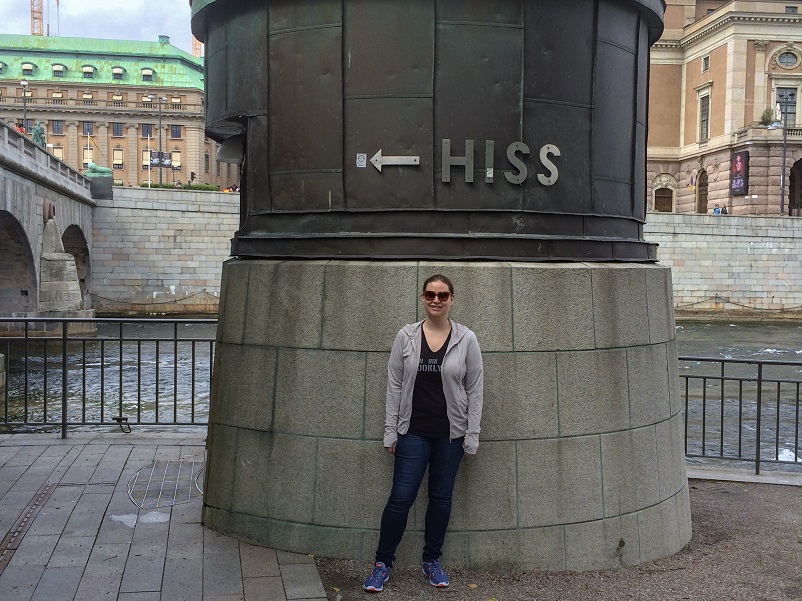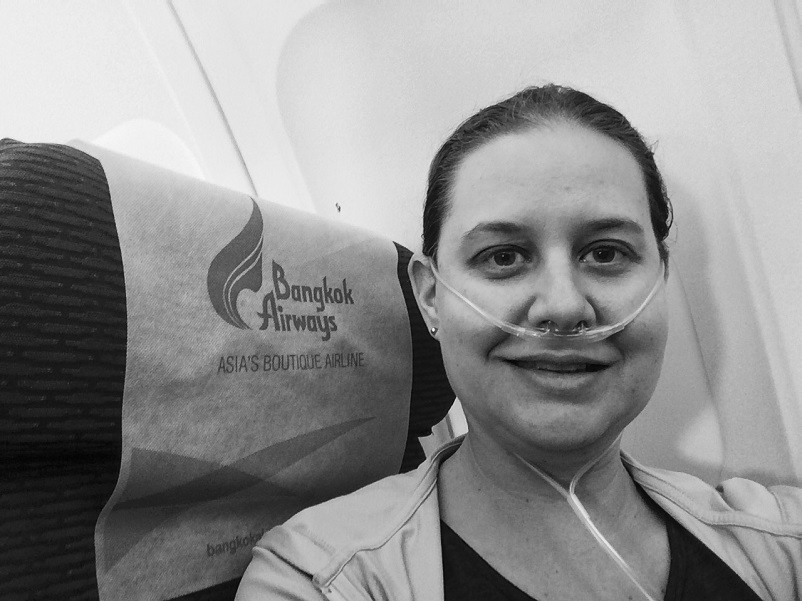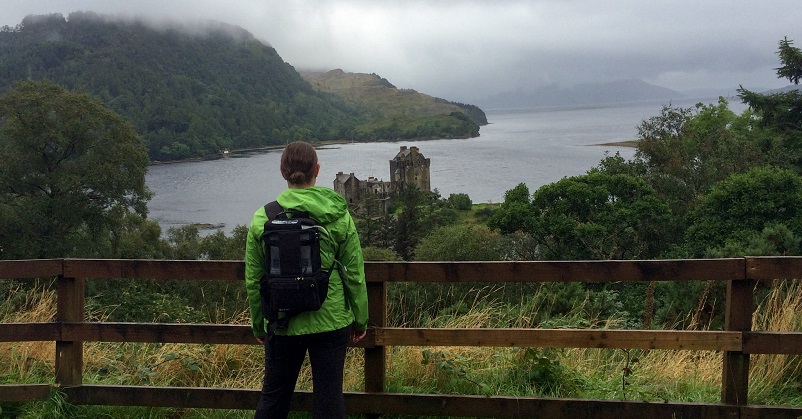Last Updated on 9th May 2021 by Sarah and Justin
Traveling isn’t only for “healthy” people. I have a rare, chronic illness and I’ve been traveling pretty much non-stop since my diagnosis almost ten years ago. In this post, I’m sharing my top tips for traveling with a lung disease. Some of them are specific to those of us with breathing problems, like advice for flying with oxygen, but a lot of them are also applicable to people traveling with a chronic disease. I originally wrote this post eight months into a year-long trip around the world. I still learn new things about how to take care of myself and enjoy myself with every new trip, but these things still hold true.
Please note, I am not a doctor and none of the below should be taken as medical advice. Please talk to your doctor if you have questions about traveling with your specific condition.
Tips for traveling with a lung disease
1. Research accommodations to ensure they have elevators or a manageable amount of stairs
There is now much more accessibility information online than there used to be when we first started traveling. But sometimes things that can make it difficult for people traveling with a lung disease are not explicitly discussed. So we read as many reviews as possible about accommodations and the areas we want to stay in. For example, a hotel might have an elevator, but the hotel itself may be located at the top of a large hill. This will often not be listed in the hotel description (unless mountain views are what you’re paying for), but is usually mentioned in the reviews if it’s an issue.
Airbnb has also added a ton more information about accessibility of their properties, but I still usually message people on the platform to get more specifics about number of stairs, etc. Everyone has always been incredibly nice and forthcoming with this information (and if they weren’t, I wouldn’t want to stay at their apartment!).
2. Take the extra time to look for elevators or escalators at public transportation stops…
…or bridges… or pretty much anywhere there are stairs. This is something I really hate doing because I am usually excited to get to wherever we’re going. But Justin always convinces me it’s for the best and I’m always grateful.
Tip: look up the word for elevator or lift in the language of the country you’re going. “Hiss” is “elevator” in Swedish!

3. Relish naps, especially after flights
Post-flight naps were actually prescribed by my doctor and I am very compliant! I also make sure to work in time to rest – if not nap – every day.
When you have a chronic illness, listening to your body when it’s tired – especially while traveling when you will probably be tempted to push it – is really important. Sometimes I don’t feel tired until I actually stop for a bit. Working a more restful activity, like coffee at a local cafe or sitting in a park, won’t detract from your trip at all. In fact, people-watching is one of our favorite travel activities.
4. Pack light
Do you really want to expend your precious energy carrying your suitcase (or make your husband carry it for you)? We usually can’t fly carry-on only, but we try our best to only bring one checked back instead of two.
Tips for packing light include researching laundry at your destination and bringing layers that can be worn in different ways more than once.
5. If you’re flying with oxygen, ensure paperwork and accessories are in order
I’ve never forgotten the portable oxygen concentrator itself, but I have forgotten accessories. And from personal experience (which involved Justin convincing a cab to speed back and forth from LaGuardia Airport to our apartment and us barely making our flight), airports typically do NOT have oxygen cannulas hanging around in a back room somewhere. Or batteries or chargers. So make sure you have all your stuff organized and ready to go (and by the front door even!) the night before your trip.
It’s also a great idea to have copies of all the forms you needed to get approved by the airline handy. I used to print them, but now I just keep them on my phone. I make sure to download them though in case I need to access something in the middle of a flight (which has happened).

6. Arrive at airports extra early
This is especially important if you fly with oxygen. Some airlines don’t let people with special medical needs check in online ahead of time, which means longer lines. And more often than not, your portable oxygen concentrator will be examined and tested by the security officers.
Also, it’s not possible for me to run through an airport for more than about 10 seconds, so I try to not put myself in the position to have to do so.
7. Make time for exercise
We walk a lot when we travel. But, it’s not like we’re power-walking everywhere we go. It is still important for me to get my heart rate up on a regular basis. While I don’t work out as much on vacation as I do normally, I still try to work in some higher-intensity exercise.
We love staying in hotels with gyms, but if that’s not possible, there are other options. We’ve gotten day passes at local gyms. I’ve power-walked around parks (with my oxygen). We’ve gone hiking. I’ve done sit-ups and push-ups and squats in hotel rooms.
I’ve definitely learned I feel better when I do this, so I make it a priority.

8. Wear sunscreen*
Of course, this is good advice for everyone. But it’s especially important for those of us who have a higher chance of getting super tired at the end of busy days. If you’re burned, you’ll be down and out come sunset.
*Note, I originally attributed these words to Kurt Vonnegut but have come to learn this was an urban legend.
9. Stay hydrated
See above but replaced “burned” with “dehydrated.” We always carry two refillable bottles of water with us wherever we go.
10. Enjoy!
And be grateful for every minute you are seeing and doing new amazing things in this world. Travel has been so therapeutic for me, I honestly consider it part of my lung disease treatment!
(And seriously, pack light).





great post on how to travel with a rare disease xx
shared on my blog 3sistersabroad.wordpress .com cheers Sarah – Bree
great tips! Especially the sunscreen tip. Those of us on certain drugs like rapamune are more sun sensitive as a result. Even after transplant it’s important to have these because of energy levels & how we respond to our drug regimens can vary. The naps might take on more importance there too. Some drugs have a side effect of drowsiness as well.
I do love the “hiss” signs for elevators in Sweden! Great post!
Aren’t they great!? Glad you enjoyed the post.
Wow a very fascinating post! I agree with every tip, definately with the napping and packing light aspect. What would you say is packing light for say a 1 month trip? The last couple trips I did involved two large pieces of luggage (around 50 pounds each) and/or a duffle bag. It was very tough.
Thanks Amber. We packed much more strategically for this journey than shorter trips, but I’ll take what I learned for the future. We each have 1 rolling duffel that weighs between 14-16 kg depending on the day and how well I pack them! We also have to carry the portable oxygen concentrator and then have 1 other backpack. I recommend using packing cubes for your clothes. Makes everything more compact. We do laundry about 1x per week so pack about 1 weeks worth of clothes (with a little extra for buffer and variety). Hope all that’s helpful!
How great that you are able to do so much traveling! I am traveling to Italy in the winter, and, despite some chronic illnesses, I’m really looking forward to it. It’s been three years since I last took a trip overseas from the U.S. I always seem to have more energy when abroad; the joy of travel, the lesiurely meals, and all of the walking do wonders for me. This time, I’m feeling a little more challenged thinking of the physical aspects of traveling, but I wouldn’t miss it for the world. It’s so great to learn from others how they accommodate any physical issues while traveling. Your article has some great suggestions. Number one is to remind myself not to be either embarrassed or discouraged if I have to seek out elevators and if I have to rest.
I’m glad you found this post helpful! Italy is such a beautiful country with the most amazing food! Have the best time and take it all at your own pace so you can enjoy it. Who cares what anyone else thinks! (Took me a while to get to that point, and I still struggle with it sometimes, but it’s good to have it as a mantra!)
I have IPF and carry a portable oxygen concentrator (POC – InogenOne G3). Your prior post re different airline requirements for POC’s was helpful in anticipating the requirements of different airlines in Asia.
Our experience (Oct.2017) on United, AirAsia (Indonesia), Scoot, AirVietnam, LaoAir and China Air could not have been easier. United requires its preflight authorization form (signed by MD), and its helpful with ChinaAir, but with my separate MD letter and the fact everyone knows and accepts InogenOne G3s, I felt we could have approached any of the airline’s special service counters and after quick inspection of the POC, assurances of adequate batteries (InogenOne dedicated), and our MD ltr, would have received boarding passes. We had no prior approval from LaoAir, and possibly AirAsia, but each was fully aware of the POC need, and the device and moved us through courteously and quickly (for the most part). The airline world in Asia at least, is comfortable with POCs. Especially if your are courteous and assertive of your knowledge of the device and the issue. Few airline personnel are, but someone with authority is quick to approve.
What your post has not said is that with an MD letter than includes reference to need for wheelchair assistance at the airport, one using a POC can have wheelchair assistance provided (with some airline, at no cost and others a nominal — $25USD cost), preboarding at the gate so no lines to stand in, and even “extra legroom” coach seats at no added cost (at least on United our last 2 international trips).
I was reluctant to consider wheelchair help until we were stuck in Mexico City for several hours before a connecting flight and my POC batteries were very low. Mexico City is about 7,300 ft elevation, higher than the pressurization of planes which require use of the POC. And we had to walk quite a ways between terminals. Ever since, I have relied on wheelchair assistance and been whisked through airports faster than I could have ever run through airports.
The only downside to relying on wheelchair assistance is that with a wheelchair, you and the wheelchair can’t have all the advantages of TSA precheck because the wheelchair must go through x-ray screening. So while you are usually taken through a different, shorter TSA line, you must take out things from your pocket, POC, oxymeter, etc. and are slowed down. Also, sometimes your belongings are separated so you must take greater care to get everything before proceeding on to the gate in your wheelchair.
But using a wheelchair and taking full advantage of the extras airlines give to help those with diminished capacity to walk great distances or stand in lines makes international air travel even more exilerating than it was before my current health issues.
Thank you very much for sharing your personal experiences traveling with a POC and wheelchair assistance. I’m particularly glad that you had such positive experiences in Asia and couldn’t agree more that knowing everything there is to know as a traveler – and being kind and courteous! – makes the process easier. You make some great points about wheelchair assistance. And of course now I’m curious about your time in Mexico City! Did you stay there long? It’s on our bucket list mainly because of the food but I’ve been hesitatant given its high elevation. I’ve never spent extended periods of time traveling at high altitude.